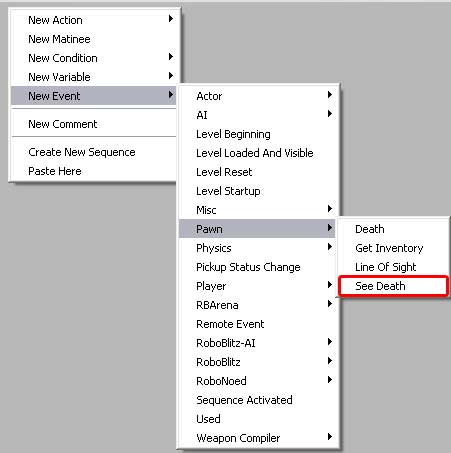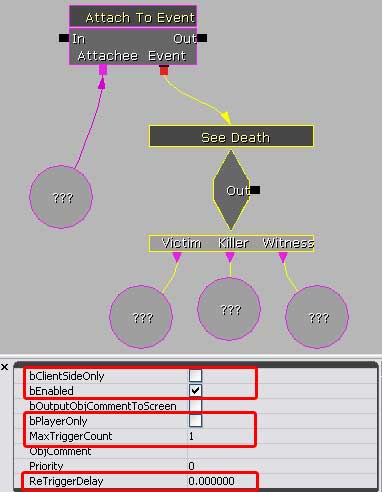|
|

|

|
|
*Note:
I created the most of the tutorials using the Roboblitz and
Gears of War editors. Based on the engine, and the version,
some properties specified may be in slightly different locations
than what is displayed in the screenshots.
If you need to learn how to create a basic map I would reccomend:
For UT99, UT2K3 & UT2K4: the Unreal
Wiki.
For UT3: Waylon's
Tutorials. |
|
|
|
|
| 
Pawn - See Death
|


|
SeeDeath fires off if the
pawn referenced via an attatch to event can see another pawn
die. Using other pawn object references you can designate
the Victim, Killer, or Witness, if needed. If they are not
needed, then the pawn will react to any death that it 'sees'.
• bClientSideOnly: This is a handy tool to optimize
events for the network. Basically, if the event is not going
to affect gameplay - if it doesn't matter to other players
- then select client only. This will prevent the event from
sending placement/rotation/physics data across the network
and trying to make sure the asset is in the same place and
the same time on everyone's computer who's in the macth. This
would be used for decorative items that have no affect on
gameplay. If, however, all the players do need to be constantly
updated with the asset's information, then make sure this
is checked off. A common dynamic asset this is necessary for
is a lift. All the players need to see where the lift actually
is at any given moment.
• bEnabled: If you combine events with toggles, this
field will allow you to turn 'off' and 'on' the event at any
time. It's enabled by default, but if you need to start with
the event 'off' and then turn it on later, uncheck bEnabled
and the event will not fire until you turn it on. Note:
This contorls the event - not the asset itself. So it is possible
to have multiple events tied to the same asset, some of which
are enabled, some disabled.
• bPlayerOnly: If you only want the Player, but not
NPC's to cause the event to fire, then check this off. Unchecked,
and anything can set off the event.
• MaxTriggerCount: This controls how many times the
Event can fire off. 0 is infinite, otherwise, the event will
stop working after it reaches the number you enter. 1 is default.
• ReTriggerDelay: If the event is allowed to fire multiple
times, this will implement a slight delay after it fires before
it can be fired again. This prevents spamming kismet signals
out of the event which is especially important if the event
is going to propagate across the network.
|

|

 |
|
|
|







|